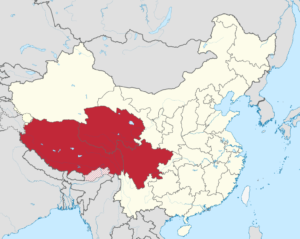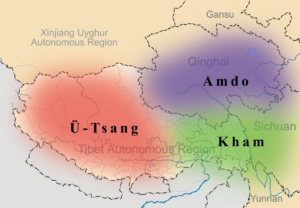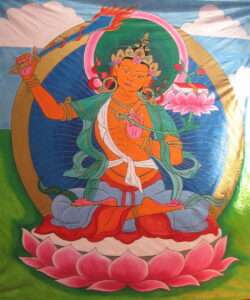Tibet's Armed Resistance to Chinese Invasion
Part 1: The feckless Tibetan government fails to prepare.

March 10 is Tibetan Uprising Day, commemorating the heroic Tibetan resistance against Chinese Communist imperialism. Over the next several days, I will tell the story of the Tibetans' fight against an evil empire, leading to the Dalai Lama's escape on March 20, 1959 and the founding of the Tibetan government in exile. Today's post describes the political and military history of Tibet in the first decades of the twentieth century, before the invasion of Mao Zedong's army in 1949.
These posts are excerpted from my coauthored law school textbook and treatise Firearms Law and the Second Amendment: Regulation, Rights, and Policy (3d ed. 2021, Aspen Publishers). Eight of the books' 23 chapters are available for free on the worldwide web, including Chapter 19, Comparative Law, where the Tibet materials appear at pages 1885-1916. The Tibet sections are part of a larger section on the most murderous regime in history, the 1949-76 dictatorship of Mao Zedong. In this post, I provide citations for direct quotes. Other citations are available in the online textbook chapter.
Although history rarely repeats itself precisely, the history of the Tibetan resistance does provide some useful lessons about factors that impede or hinder armed resistance to tyranny.
During the 1950s, the greatest armed resistance to Mao's rule was in Tibet. "The Tibetan Revolt was a major international embarrassment for the Chinese and for Mao; it must be considered one of the factors in Mao's eclipse and in the retrenchment polices of the early 1960s." Warren W. Smith, "The Nationalities Policy of the Chinese Communist Party and the Socialist Transformation of Tibet," in Resistance and Reform in Tibet 53, 67-68 (Robert Barnett & Shirin Akiner eds. 1994).
In other words, the Tibetan resistance helped to force Mao to end his Great Leap Forward, a policy that had forced the Chinese peasantry into communal slave labor, and caused the worst famine in human history, killing tens of millions. By indirectly helping to terminate the so-called Great Leap Forward, the Tibetan resistance saved millions of Chinese lives.
Tibet's geography and autonomy
Earlier sections of Chapter 19 of the Firearms Law textbook present case studies of Armenian and other Christian resistance to genocide in Turkey during World War I, and of Jewish resistance to the Holocaust during World War II. Unlike the Ottoman Christians or the European Jews, Tibetans had a very strong and longstanding gun culture. They immediately recognized that orders to register or surrender their guns were orders to submit to imminent enslavement.

Historically, Tibet comprised three large provinces: Kham (southeast), Amdo (northeast), and U-Tsang (west). Over half the Tibetan population lived in the two eastern provinces. The national capital is Lhasa, in U-Tsang. Kham and Amdo are often referred to as Eastern Tibet, while the U-Tsang area comprises most of Central Tibet. Central Tibet also includes Chamdo, the westernmost province of Kham. Resistance by the Khampos of Chamdo would help draw the rest of Central Tibet into the armed revolt against Chinese invaders.

Tibet had long exercised autonomy while acknowledging the suzerainty of another empire, either Mongol or Chinese. "Suzerainty" was a deliberately vague term. To the extent the meaning can be pinned down, it means nominal sovereignty over an internally autonomous or semi-independent state. Hugh Richardson, High Peaks, Pure Earth: Collected Writings on Tibetan History and Culture 625-30 (Michael Aris ed. 1998).
In the Tibetan view, this was a reciprocal priest-patron relationship. The Tibetan Buddhists, as priests, provided religious leadership, and the patrons helped to protect Tibet. The priest-patron model was reasonably accurate for Tibetan relations with the Mongols, who embraced the Buddhism they learned from the Tibetans. Notwithstanding Tibetan pride, priest-patron was not how the Chinese treated Sino-Tibetan relations, as the Chinese were disinclined to think they had anything to learn from mountain barbarians. All of Tibet was beyond "China proper" and the Great Wall. Supplying a foreign military presence in Central Tibet was especially difficult, resulting in de facto independence for long periods.
In the mid-eighteenth century, China's Manchu Dynasty wrested much of Kham and Amdo from Tibet and held onto them until the dynasty fell in 1911. After a failed 1905 uprising of Tibetans in China's Yunnan and Sichuan provinces, the Manchu Dynasty began a campaign to eradicate the Buddhist clergy, and to populate Tibetan areas with poor peasants from Sichuan. In 1910, a bloodthirsty Chinese army led by Zhao Erfeng took over Lhasa and drove the thirteenth Dalai Lama into exile.
Whatever nominal allegiance Tibet thought it might owe to the Manchu Dynasty in Peking (which the Communists later renamed Beijing), Tibet felt no obligation to the brand-new Republic of China. On August 12, 1912, the Tibetans rose up and expelled the Chinese army.
During 1917-18, Tibet repelled an attack by the Republic of China, and then advanced into Tibetan ethnic areas formerly under Chinese control, reacquiring them in the 1918 Treaty of Rongbatsa. But in 1931-32, the Republic of China pushed the Tibet army back to the Yangtze (Tibetan Drichu) River.
The most thorough attempt to delineate the Tibet-China-India borders based on historical practice was the 1914 Simla Accord. In the three-way negotiations between Tibet, China, and British India, the Tibetans produced extensive documentary evidence for their claims, while the Chinese had bare assertion. The Simla Accord divided Tibet into "Outer Tibet" (Central Tibet plus some of Eastern Tibet) and "Inner Tibet" (the rest of Eastern Tibet). The parties recognized "the suzerainty of China" and also "autonomy" and "territorial integrity" of the "country" of Outer Tibet. Simla Accord, art. 2. China would not convert Tibet into a Chinese province, and Great Britain would not annex any portion of Tibet. Id. Neither China nor Great Britain would send troops into Tibet (with some small specified exceptions); neither would interfere with the civil administration of Outer Tibet by the "Tibetan Government in Lhasa." Id. arts. 3-4. As for Inner Tibet, "[n]othing in the present Convention shall be held to prejudice the existing rights of the Tibetan Government in Inner Tibet, which include the power to select and appoint the high priests of monasteries and to retain full control in all matters affecting religious institutions." Id. art. 9. A map attached to the treaty delineated the borders of Inner Tibet and Outer Tibet. Id.
Although the three negotiating parties had agreed to the Simla Accord, the Chinese central government ultimately refused to ratify it because it wanted a different boundary, even though Simla had attempted to placate China by assigning to Inner Tibet many areas where Outer Tibet had the better claim. Tibet and Great Britain mutually agreed to adhere to the accord; they stated that China was debarred from enjoyment of the accord's benefits until China ratified it.
Whatever the legal effects of the Simla Accord, the reality on the ground remained the same: "there was no modern boundary between Tibet and China; instead there were overlapping zones, open zones, and locally governed territories, both lay and monastic." Carole McGranahan, "From Simla to Rongbatsa: The British and the 'Modern' Boundaries of Tibet," 28 Tibet J. 39, 40 (2003). Kham was "mostly under the local control of hereditary kings, chiefs, and lamas. . . ." Id. Tibetans and Chinese did not think of the contested regions in the sense that European nation-states had defined their own borders—as exact lines where a nation enjoyed 100 percent sovereignty on its side, and no sovereignty on the other. The situation remained unchanged until the Chinese invasion that would come in 1949.
Starting in 1931, the Japanese invasion of Manchuria distracted the Republic of China. "By the mid-1930s, most of Tibet was again enjoying de facto independence." Kenneth
Conboy & James Morrison, The CIA's Secret War in Tibet 5 (2002).
As a practical matter, the Eastern Tibetans who lived within areas claimed by China or Tibet mostly governed themselves. Many were pastoralists or nomads. To the extent that they felt any allegiance to a faraway capital, it was to Lhasa, with whom they shared language and religion, and not to the more distant Peking or Nanking. (Nanking was the capital of the Republic of China from 1927-37 and 1945-49, and had sometimes been the imperial capital in previous centuries).
While always respectful of the Dalai Lama, Kham's leaders did not necessarily feel responsible to the government in Lhasa. Likewise, before communism was imposed, the Amdowas (northeastern Tibet) comprised hundreds of nomadic tribes, each with "its own army, temples, and laws." Jianglin Li, Tibet in Agony: Lhasa 1959 at 45 (2016). The Eastern Tibetans would contribute the greatest armed resistance to Maoist imperialism.
Today, the "Tibet Autonomous Region," formally created in 1965 by the People's Republic of China, does not include vast areas of historic or ethnic Tibet. Most of Amdo has been transferred to China's Qinghai province, plus a smaller part to Gansu. While the Chamdo region of Kham is in the Tibet Autonomous Region, most of Kham is presently divided between China's Qinghai, Sichuan, and Yunnan provinces. Tibetan ethnic areas constitute a quarter of the territory of the People's Republic of China.
The moral duty to use force to end suffering
Tibetan identity has long been closely tied to Tibetan Buddhism (Vajrayana), which is distinct from the Hinyana (a/k/a Theravāda), Mahayana, or Zen sects of other nations. While Buddhist scriptures are predominantly pacifist, they are not exclusively so. The martial arts were created by Buddhist teachers. Buddhist nations have employed armed force for self-defense as much as other nations. The core principle of Buddhism is ahimsa, compassion for the suffering of others. In the views of many Buddhists, including the present Dalai Lama, ahimsa permits the choice to reduce the suffering of others by using violence, including deadly force, against the persons causing the suffering. See David B. Kopel, "Self-defense in Asian Religions," 2 Liberty L. Rev. 79 (2007).

Tibetan Buddhists were familiar with the martial example Manjushri (Manjushree, Manjusri), Bodhisattva of Wisdom. He had transformed himself in a successful mission to kill Death. Many paintings depicted him with a holy book in one hand and a flaming sword in the other. Manjusri's sword cut through the roots of ignorance. Another bodhisattva, Vajrapani, pugnaciously defended embattled guardians of the Buddhist faith. The Epic of King Gesar told the historical (according to Tibetans) story of the great warrior king from days of yore who fought enemies of dharma—Buddhist teachings and the natural order of existence.
"Tibetan history was littered with examples of monks taking up arms when Buddhism was perceived as being threatened. . . . [W]hen defending the faith, monks could be the most magnificent of soldiers," with a stamina and rigor fortified by the monastic lifestyle. Mikel Dunham, Buddha's Warriors: The Story of the CIA-Backed Tibetan Freedom Fighters, the Chinese Invasion, and the Ultimate Fall of Tibet 149 (2004).

Tibet is not exclusively Buddhist. There had long been a Muslim minority that was respected and religiously free. There were four mosques in Lhasa alone. The Bon religion arose around the tenth century and was persecuted as a rival to Buddhism. By the twentieth century, it existed mainly in eastern Tibet, well beyond Lhasa's control.
The Dalai Lama's Proposal for Collective Defense
While Tibet was independent, the then-Dalai Lama, Thupten Gyatso (birthname Choekyi Gyaltsen), proposed a Tibet-Nepal-Bhutan defense alliance, with military training for young men. Although the Dalai Lama was head of state, much of the political power in Tibet's quasi-feudal theocracy was held by three large monasteries in Lhasa. Their armed monks, the dob-dobs, outnumbered Tibet's tiny army and police. As military buildup would have required substantial taxes on the monasteries, the monasteries squashed the plan. Nepal and Bhutan rejected the alliance proposal.
In a "Political Last Testament" in August 1932, Dalai Lama Thupten Gyatso wrote:
Efficient and well-equipped troops must be stationed even on the minor frontiers bordering hostile forces. Such an army must be well-trained in warfare as a sure deterrent against any adversaries.
Furthermore, the present era is rampant with the five forms of degeneration, in particular the "red" ideology. [He then summarized communist abuses of Buddhism in Outer Mongolia.] In the future, this system will certainly be forced either from within or without on this land. . . . If, in such an event, we fail to defend our land, the holy lamas . . . will be eliminated without a trace of their names remaining. . . . Moreover, our political system . . . will be reduced to an empty name; my officials . . . will be subjugated like slaves to the enemy; and my people, subjected to fear and miseries, will be unable to endure day or night. Such an era will certainly come.
Roger E. McCarthy, Tears of the Lotus: Accounts of Tibetan Resistance to the Chinese Invasion, 1950-1962, at 37-38 (1997).
Would the defense system have saved Tibet? "I'm convinced it would have," said the current Dalai Lama, Tenzin Gyatso. Dalai Lama with Jean-Claude Carrière, Violence and Compassion: Dialogues on Life Today 149 (1996) (originally published in France as La Fource du Bouddhisme (1994)).
In the Tibetan Buddhist system, after the death of the Dalai Lama or the Panchen Lama (second-ranking), the people would wait until his reincarnated soul was discovered in a young boy. The thirteenth Dalai Lama died in 1933; Lhamo Thondup was born in 1935. Identified as a possible Dalai Lama when he was a small child in a small Amdo village, he was enthroned in 1940, taking the religious name Tenzin Gyatso. Since Dalai Lamas were chosen in early childhood, there would always be a number of years before the child reached maturity and could assume leadership. In the interim, Tibet would be governed by a regency. As history demonstrates, regencies can be dangerous, because the government is often weak and subject to intrigues. After the death of the thirteenth Dalai Lama, "the Tibetan Government, such as it was, appeared oblivious to the need for national reform to prepare for the challenges ahead." Premen Addy, "British and Indian Strategic Perceptions of Tibet," in Resistance and Reform in Tibet at 35. The regent "allowed the military to decline, while lining his pockets at the expense of Tibetan economic surpluses." Dunham at 49.
The current, fourteenth, Dalai Lama has stated that he may decide not to be reincarnated. His primary motivation seems to be the avoidance of communist interference in the selection process. The communist rulers of today's China, although officially atheist, have asserted authority over the "control and recognition of reincarnations." The Dalai Lama notes that the communist Chinese "are waiting for my death and will recognize a Fifteenth Dalai Lama of their choice." The Dalai Lama, Reincarnation (Sept. 24, 2011). After China declared that the next Dalai Lama's selection process "must comply with Chinese law," the current Dalai Lama replied, "In future, in case you see two Dalai Lamas come, one from here, in free country, one chosen by Chinese, then nobody will trust, nobody will respect [the one chosen by China]." Sophia Yan, "China Says Dalai Lama Reincarnation 'Must Comply' with Chinese Laws," The Telegraph, Mar. 21, 2019.
Tibetan Arms Culture
Tibetans had a long tradition of being armed, but many of their firearms were flintlocks or matchlocks, which had long been obsolete in most of the rest of the world.
Matchlocks are impossible to keep always-ready, ill suited for long distance, poor for maintaining the user's concealment, and quite slow to reload after the single shot. Flintlocks were better in all respects, but still far inferior to firearms invented since the mid-nineteenth century, which used metallic cartridges, and which were much faster to reload and more powerful. Tibet was economically backwards and had no firearms manufacturing industry. Tibetans could and did make their own swords and knives.
During World War II, Tibet stayed neutral, and did not authorize Allied arms shipments to the Republic of China's army that was battling Japanese invasion. Nevertheless, wartime conditions tend to increase the gun supply, and Tibetans, especially in Kham, seem to have taken the opportunity to acquire a wide variety of modern firearms, some of them purchased in Burma and then imported.
Tibet's formally organized military forces were small. As of the mid-1930s, Eastern Tibet had about ten thousand regulars and militia; half of them had modern British Lee-Enfield .303 bolt action rifles. In Lhasa there were under a thousand soldiers plus 300 armed police. In most of the nation, defense was provided only by militia armed with matchlocks. Military training in general was desultory. On the eve of the 1949 communist invasion, "Tibet's army—if you could call it that—was at most ten thousand troops with nineteenth century weapons." Dunham at 56.
Although many Tibetan firearms were inferior, Tibet's arms culture was strong. High proficiency at riding, shooting, and swordsmanship were part of Tibetan identity, and the skills were learned early in childhood. Such skills had always been necessary for survival—whether for protection against bandits, or for hunting in an environment where neither game nor ammunition were abundant.
"Khampas were heavily armed," skilled at brigandage, and "incomparable horsemen, hunters, and trackers." Dunham at 7. "Every self-respecting male owned at least one silver embellished pistol or rifle, even if it was nothing more than a flintlock. The poorest of beggars carried a sword or oversized knife hitched at his waist, and he knew how to use it." Id. at 17. Wealthy families had arsenals. So did the monasteries, with their warrior monks, the dob-dobs.
When the war began, man for man the Tibetans were far superior to the China's misnamed People's Liberation Army (PLA). The Tibetans often inflicted casualties on the Chinese at about ten times the rate that the Chinese did on them. Unlike the Tibetans, the Chinese were poor marksmen. While the PLA demanded unthinking obedience, the Tibetans knew how to think for themselves, to improvise and survive. In combat, PLA officers did not lead their men, but instead stayed in the rear, to shoot those who tried to escape.
According to a captured Chinese army document, PLA soldiers fired 20 bullets per Tibetan guerilla killed, whereas for Tibetans shooting at the PLA, the norm was one shot, one kill.
Moreover, the average altitude of Kham and Amdo is over 3,000 meters (about 10,000 feet), and even higher in Central Tibet. Tibetan physiology has evolved such that Tibetans breathe easily in very thin air, whereas invading lowlanders have a much more difficult time.
Supported and sheltered by the Tibetan people, Tibet's guerillas could hit, run, and disappear. "Many people think it impossible for guerrillas to exist for long in the enemy's rear. Such a belief reveals lack of comprehension of the relationship that should exist between the people and the troops. The former may be likened to water the latter to the fish who inhabit it. How may it be said that these two cannot exist together? It is only undisciplined troops who make the people their enemies and who, like the fish out of its native element cannot live." Mao Tse-tung, On Guerrilla Warfare, ch. 6 (1937).
When the Chinese communists invaded Tibet, the corrupt Tibetan government failed, but the Tibetan people rose up nonetheless, as will be described in the next post.
